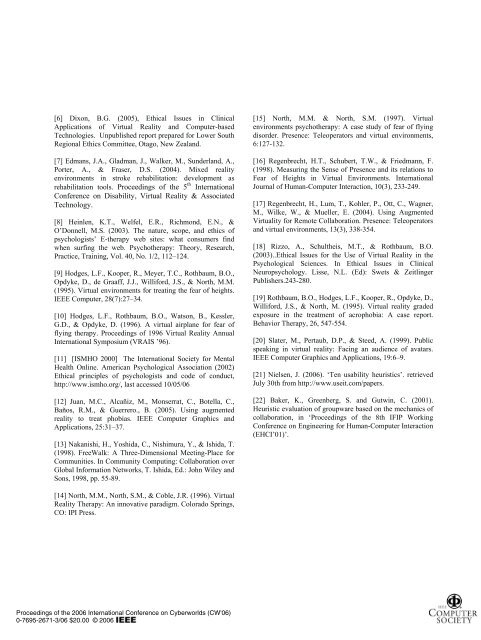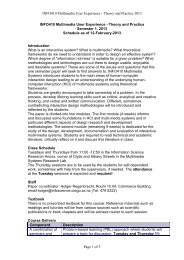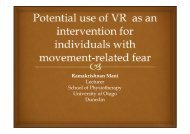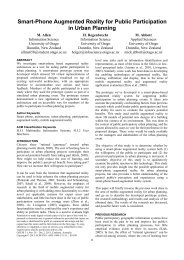View - HCI
View - HCI
View - HCI
You also want an ePaper? Increase the reach of your titles
YUMPU automatically turns print PDFs into web optimized ePapers that Google loves.
[6] Dixon, B.G. (2005), Ethical Issues in ClinicalApplications of Virtual Reality and Computer-basedTechnologies. Unpublished report prepared for Lower SouthRegional Ethics Committee, Otago, New Zealand.[7] Edmans, J.A., Gladman, J., Walker, M., Sunderland, A.,Porter, A., & Fraser, D.S. (2004). Mixed realityenvironments in stroke rehabilitation: development asrehabilitation tools. Proceedings of the 5 th InternationalConference on Disability, Virtual Reality & AssociatedTechnology.[8] Heinlen, K.T., Welfel, E.R., Richmond, E.N., &O’Donnell, M.S. (2003). The nature, scope, and ethics ofpsychologists’ E-therapy web sites: what consumers findwhen surfing the web. Psychotherapy: Theory, Research,Practice, Training, Vol. 40, No. 1/2, 112–124.[9] Hodges, L.F., Kooper, R., Meyer, T.C., Rothbaum, B.O.,Opdyke, D., de Graaff, J.J., Williford, J.S., & North, M.M.(1995). Virtual environments for treating the fear of heights.IEEE Computer, 28(7):27–34.[10] Hodges, L.F., Rothbaum, B.O., Watson, B., Kessler,G.D., & Opdyke, D. (1996). A virtual airplane for fear offlying therapy. Proceedings of 1996 Virtual Reality AnnualInternational Symposium (VRAIS ’96).[11] [ISMHO 2000] The International Society for MentalHealth Online. American Psychological Association (2002)Ethical principles of psychologists and code of conduct,http://www.ismho.org/, last accessed 10/05/06[12] Juan, M.C., Alcañiz, M., Monserrat, C., Botella, C.,Baños, R.M., & Guerrero., B. (2005). Using augmentedreality to treat phobias. IEEE Computer Graphics andApplications, 25:31–37.[13] Nakanishi, H., Yoshida, C., Nishimura, Y., & Ishida, T.(1998). FreeWalk: A Three-Dimensional Meeting-Place forCommunities. In Community Computing: Collaboration overGlobal Information Networks, T. Ishida, Ed.: John Wiley andSons, 1998, pp. 55-89.[15] North, M.M. & North, S.M. (1997). Virtualenvironments psychotherapy: A case study of fear of flyingdisorder. Presence: Teleoperators and virtual environments,6:127-132.[16] Regenbrecht, H.T., Schubert, T.W., & Friedmann, F.(1998). Measuring the Sense of Presence and its relations toFear of Heights in Virtual Environments. InternationalJournal of Human-Computer Interaction, 10(3), 233-249.[17] Regenbrecht, H., Lum, T., Kohler, P., Ott, C., Wagner,M., Wilke, W., & Mueller, E. (2004). Using AugmentedVirtuality for Remote Collaboration. Presence: Teleoperatorsand virtual environments, 13(3), 338-354.[18] Rizzo, A., Schultheis, M.T., & Rothbaum, B.O.(2003)..Ethical Issues for the Use of Virtual Reality in thePsychological Sciences. In Ethical Issues in ClinicalNeuropsychology. Lisse, N.L. (Ed): Swets & ZeitlingerPublishers.243-280.[19] Rothbaum, B.O., Hodges, L.F., Kooper, R., Opdyke, D.,Williford, J.S., & North, M. (1995). Virtual reality gradedexposure in the treatment of acrophobia: A case report.Behavior Therapy, 26, 547-554.[20] Slater, M., Pertaub, D.P., & Steed, A. (1999). Publicspeaking in virtual reality: Facing an audience of avatars.IEEE Computer Graphics and Applications, 19:6–9.[21] Nielsen, J. (2006). ‘Ten usability heuristics’. retrievedJuly 30th from http://www.useit.com/papers.[22] Baker, K., Greenberg, S. and Gutwin, C. (2001).Heuristic evaluation of groupware based on the mechanics ofcollaboration, in ‘Proceedings of the 8th IFIP WorkingConference on Engineering for Human-Computer Interaction(E<strong>HCI</strong>’01)’.[14] North, M.M., North, S.M., & Coble, J.R. (1996). VirtualReality Therapy: An innovative paradigm. Colorado Springs,CO: IPI Press.Proceedings of the 2006 International Conference on Cyberworlds (CW'06)0-7695-2671-3/06 $20.00 © 2006










